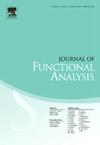An improved dense class in Sobolev spaces to manifolds
IF 1.7
2区 数学
Q1 MATHEMATICS
引用次数: 0
Abstract
We consider the strong density problem in the Sobolev space of maps with values into a compact Riemannian manifold . It is known, from the seminal work of Bethuel, that such maps may always be strongly approximated by -valued maps that are smooth outside of a finite union of -planes. Our main result establishes the strong density in of an improved version of the class introduced by Bethuel, where the maps have a singular set without crossings. This answers a question raised by Brezis and Mironescu.
In the special case where has a sufficiently simple topology and for some values of s and p, this result was known to follow from the method of projection, which takes its roots in the work of Federer and Fleming. As a first result, we implement this method in the full range of s and p in which it was expected to be applicable. In the case of a general target manifold, we devise a topological argument that allows to remove the self-intersections in the singular set of the maps obtained via Bethuel's technique.
求助全文
约1分钟内获得全文
求助全文
来源期刊
CiteScore
3.20
自引率
5.90%
发文量
271
审稿时长
7.5 months
期刊介绍:
The Journal of Functional Analysis presents original research papers in all scientific disciplines in which modern functional analysis plays a basic role. Articles by scientists in a variety of interdisciplinary areas are published.
Research Areas Include:
• Significant applications of functional analysis, including those to other areas of mathematics
• New developments in functional analysis
• Contributions to important problems in and challenges to functional analysis

 求助内容:
求助内容: 应助结果提醒方式:
应助结果提醒方式:


